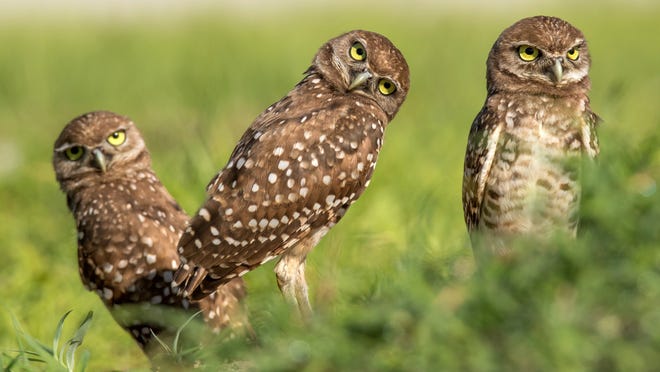City of Marco Island may soon pay homeowners to dig starter owl burrows in front yards
 Omar Rodríguez Ortiz
Omar Rodríguez Ortiz
Marco Island City Council might approve in January a program that would pay homeowners to dig starter owl burrows in their front yards.
The Safe Harbor Management program is designed to reward homeowners who allow active owl burrows on their property, according to Vice-Chair Jared Grifoni.
"It allows them to participate in the program to encourage threatened species to come to their lot or their home," Grifoni said at a City Council meeting on Dec. 2.
At the meeting, City Council directed its attorney to revise the incentive program proposal in time for the 2020 nesting season, which starts in February.
Each participant who maintains an active burrow for one year will receive about $250 from the city, according to Grifoni. The exact amount has yet to be decided.
In the event that the property owner sells or another change occurs, the Safe Harbor program can allow the land to return as it was "without any penalties, financial or otherwise," Grifoni said.
"They have to get a permit to remove the owl nest not in breeding season."
City Council set aside $5,000 in the 2020 budget to begin the program, according to Grifoni.
It is possible to increase fines for people who intentionally and knowingly harass or disturb owl burrows and use the money to fund the program in the future, Grifoni said.
A man recently put mothballs into an owl burrow in a Marco empty lot, the Eagle reported.
Florida Fish and Wildlife Conservation Commission identified Roger M. Fleming, the owner of the lot, as the only suspect.
Burrowing owls are designated by the state as a threatened species, according to the FWC's website.
From October:Video shows realtor putting mothballs in Marco Island owl burrow, Audubon says
From November:Marco Island requests continuance in case of realtor putting mothballs in owl burrow
And:Burrowing owls under attack on Marco Island but many fight to protect them
"It would be good for the taxpayers, and it would be good to take from those who are causing harm and giving to those who are trying to do some good for Marco Island and for the burrowing owls," Grifoni said. "That's up for discussion."
Brad Cornell, policy associate of Audubon of the Western Everglades, said the initiative is part of a research program.
"We are trying to figure out whether this is an effective way to stabilize an urban owl population in the state of Florida," Cornell said. "We have some preliminary numbers that are encouraging but certainly not final.
"As we develop vacant lots on the island, it is clear that we need to figure out something that will allow us keep burrowing owls."
In the fall of 2017, Audubon's Owl Watch program staff began meeting with Marco homeowners who want starter burrows in their front yards, said Allison Smith, manager of the program.
"We dig a hole a feet deep at an angle, we pile all the sand next to it so it looks like an owl burrow and we put a wooden perch for them to stand on," Smith said.
Then it's just a matter of time before burrowing owls start moving in, she said.
Of 89 starter burrows 25 percent have successfully attracted owls, Smith said.
The vast majority of burrowing owls live on vacant lots. As people build new houses, the owls may eventually run out of places to live, according to Smith.
The 2019 nesting season resulted in 252 nesting owl pairs established on the island, raising as many as a thousand young owlets, the Eagle reported. That's 58 more pairs than the previous year.
"The island is developing pretty rapidly, but in 20 years there may not be enough vacant lots," Smith said.
City Council's next meeting is scheduled for Monday, Jan. 6.
‘Owl in the Family’:Burrowing owls have learned to coexist with Islanders